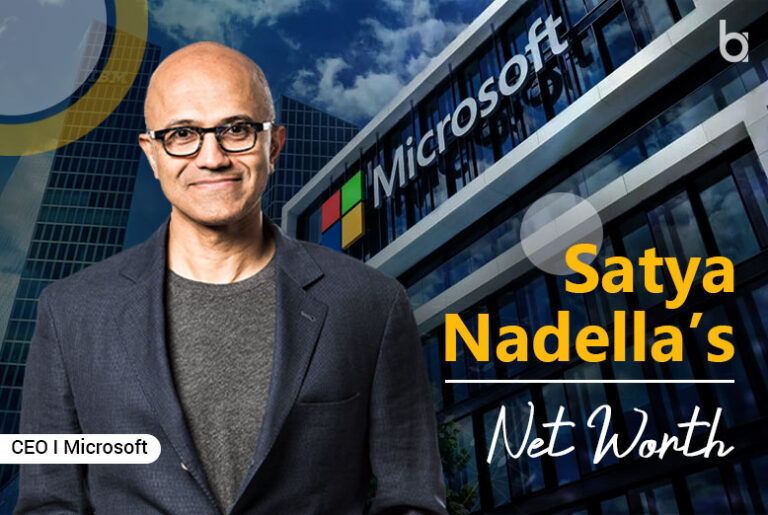In the world of billionaires, some stories just hit differently.
They aren’t only about money; they’re about vision, heart, and a complete reimagining of what’s possible. Satya Nadella’s net worth story is one of those.
Seriously, his journey from Hyderabad, India, to the CEO chair at Microsoft is more than just a corporate ladder-climb—it’s a masterclass in building a legacy.
As of today, his net worth has shot up to an incredible $1.1 billion. How did he do it? It wasn’t luck. It was a perfect storm of genius-level strategy, empathetic leadership, and some incredibly smart personal money moves.
Let’s pull back the curtain and see exactly how he built this empire, piece by piece. This isn’t just a financial report; it’s the story of a revolution.
Let’s Explore Satya Nadella’s Net Worth Journey
1. Satya Nadella’s Early Life and Educational Foundations
Picture this: A young boy, Satya Narayana Nadella, born on August 19, 1967, in the vibrant city of Hyderabad, India. He grew up in a home that was all about learning. His dad, Bukkapuram Nadella Yugandhar, was a respected Indian Administrative Service officer, and his mom, Prabhavati, was a Sanskrit lecturer. Can you feel that intellectual energy?
He went to the prestigious Hyderabad Public School in Begumpet, building a solid academic base. For a while, his big dream was to become a professional cricket player! But his love for science and technology ultimately won out, setting him on a path that would change the world.
He didn’t just stop at one degree. He first earned a Bachelor’s in Electrical Engineering from the Manipal Institute of Technology in 1988. Then, he made the life-changing move to the United States, getting a Master’s in Computer Science from the University of Wisconsin-Milwaukee in 1990. But here’s the super-impressive part: while already working at Microsoft, he pursued and completed his MBA from the University of Chicago’s Booth School of Business in 1997. That combination of deep tech knowledge and sharp business strategy? That was the launchpad for everything to come.
2. Pre-Microsoft Career: Forging Skills at Sun Microsystems
Before his legendary run at Microsoft, Satya got his start in the heart of Silicon Valley at Sun Microsystems. From 1990 to 1992, he worked as a member of their technology staff. It might seem like a short gig, but this was where he cut his teeth in the fiercely competitive world of enterprise tech. It was the perfect warm-up, giving him the insights and skills he’d need for the marathon ahead at Microsoft.
3. The Microsoft Saga: A Trajectory of Transformation and Wealth
This is where the story truly ignites. Satya joined Microsoft in 1992 as a young, ambitious engineer. His first projects? Foundational stuff, like the Windows NT operating system. He was so driven that he would commute every single week from Microsoft’s Redmond campus all the way to Chicago to finish his MBA. Think about that dedication! It’s just incredible.
By 1999, he’d earned his first executive title: Vice President of Microsoft bCentral. Just two years later, in 2001, he was promoted to Corporate Vice President of Microsoft Business Solutions. His responsibilities were expanding, and so was his vision.
In 2007, another huge leap: he became Senior Vice President of R&D for Microsoft Online Services. This put him in charge of massive products like the Bing search engine and the early versions of what would become Office 365. He was now shaping both consumer tech and the budding cloud world.
But the game-changing move came in February 2011. Satya was named President of Microsoft’s Server and Tools Division. This wasn’t just any division; it was a revenue powerhouse that held the keys to the future: the Azure cloud platform. Under his watch, revenue from Cloud Services exploded from $16.6 billion in 2011 to $20.3 billion by June 2013. He was betting the farm on a cloud-first future, and boy, was it paying off.
Then, on February 4, 2014, the moment arrived. Satya Nadella became the third CEO in Microsoft’s history. What he did next was nothing short of miraculous. He inherited a company worth around $300 billion and transformed its very soul, introducing a culture of empathy and a ‘growth mindset.’ The result? Microsoft’s market value skyrocketed from $300 billion to over $3 trillion. A tenfold increase! That’s how a CEO’s vision translates directly into billionaire status.
4. Deconstructing the Billion-Dollar Fortune
So, how does that $1.1 billion fortune actually break down? It’s a fascinating mix of his massive Microsoft compensation and some very shrewd personal investments.
● Executive Compensation at Microsoft
Satya’s pay is brilliantly designed to tie his success directly to the company’s. His base salary has been a steady $2.5 million. But the real magic is in the performance-based bonuses.
For the 2024 fiscal year, his total compensation hit a staggering $79.1 million—a 63% jump from the $48.5 million he earned in 2023. But here’s something that speaks volumes about his character: facing some cybersecurity challenges, he personally requested a reduction in his cash incentive, taking home $5.2 million instead of the $10.66 million he was eligible for. That’s leadership.
The heart of his fortune lies in stock awards. In 2024, these amounted to about $71.2 million. Since he took the helm, Microsoft’s stock price has surged by nearly 1,000%. Revenue has almost tripled to $245.1 billion, and net income has quadrupled to $88.1 billion. When the company wins, he wins. It’s as simple and as powerful as that.
● Strategic Investments
Beyond Microsoft, Satya has an amazing eye for the next big thing. He’s an angel investor in companies like Groww, an Indian investment platform now valued at $3 billion, where he also serves as an advisor. He also invested in Drata, a compliance automation platform, participating in their $200 million funding round in December 2022, which helped it hit a $2 billion valuation. He’s not just leading a tech giant; he’s fueling the next generation of them.
● Business and Sporting Ventures
And it’s not all about tech! Satya invests in his passions. He and his wife, Anupama, are part of the ownership group of the Seattle Sounders FC, the local Major League Soccer team. Talk about community spirit!
Even more personally, he’s a co-owner of the Seattle Orcas, a professional cricket team in the U.S. Major League Cricket. This beautifully connects his love for the sport from his childhood in India with a savvy business move in a growing American market. It’s a full-circle moment!
● Real Estate Holdings
Even titans need a place to call home. Satya has made some smart real estate moves, too. He bought a home in Clyde Hill, Washington, back in 2000 for about $1.8 million. He later sold it in May 2016 for around $2.775 million—more than doubling his investment. Not bad! Today, he and his family live in a beautiful home in Bellevue, Washington, valued at over $7.5 million.
● Literary Works
In 2017, Satya penned ‘Hit Refresh.’ This book is so much more than a memoir. It’s his personal playbook for transforming a company’s soul, built on empathy and a ‘learn-it-all’ mindset. And in another incredible gesture, all profits from the book are dedicated to Microsoft Philanthropies. The book didn’t just share his ideas; it cemented his global reputation as a truly visionary leader.
● Board Memberships and Endorsements
Satya’s influence extends to other boardrooms. He served on the Board of Directors for Starbucks from 2017 until May 2024, earning about $309,917 a year for his duties. He also serves as a trustee at the Fred Hutchinson Cancer Research Center and the University of Chicago. These roles don’t just add to his income; they weave him into the fabric of corporate and philanthropic leadership.
● Achievements and Awards
The accolades speak for themselves. In 2019, he was named Financial Times Person of the Year and Fortune Businessperson of the Year. In 2020, he received the Padma Bhushan, one of India’s highest civilian honors. Being consistently named one of TIME’s 100 Most Influential People (in 2018 and 2024) just confirms his immense global impact. These aren’t just trophies; they are proof that his leadership works.
5. Major Challenges
This journey wasn’t without its dragons to slay. When Satya became CEO, Microsoft was struggling with a ‘know-it-all’ culture that stifled innovation. His greatest triumph was transforming it into a vibrant ‘learn-it-all’ culture of collaboration.
He also had to steer the ship through turbulent waters, as Microsoft had fallen behind in mobile and cloud. His pivot to a cloud-first strategy with Azure and his bold partnership with OpenAI were strokes of genius. He faced crises, like cybersecurity breaches, with a calm, transparent, and accountable hand—even taking a personal pay cut. This ability to turn huge challenges into catalysts for growth has been the secret to Microsoft’s—and his own—stunning success.
My Opinion
Let’s be clear: Satya Nadella’s net worth is the direct result of a brilliant two-part strategy. First, he drove unprecedented growth at Microsoft, which supercharged the value of his stock awards. Second, he intelligently diversified that wealth with smart personal investments.
His ‘Fast Follower’ approach in AI and the cloud made Microsoft a powerhouse, and his stakes in ventures like Groww, Drata, and his beloved sports teams show a shrewd mind that sees value everywhere. It’s a master blueprint for wealth creation.
Here are some Lessons from Satya Nadella’s Journey
- Cultivate a ‘Learn-It-All’ Mindset:
He proved that being curious is more powerful than being right. This simple shift in thinking can unlock unbelievable growth in your own life and career.
- Empathy is a Superpower:
Nadella showed the world that understanding people—customers, employees, partners—is the most powerful business tool there is. It leads to better ideas and unbreakable bonds.
- Dare to Work with Your Rivals:
He embraced ‘co-opetition,’ working with competitors like Apple and Linux. This radical idea taught us that you can create a bigger pie for everyone instead of just fighting for your slice.
- Invest in Your Passions:
His investments in soccer and cricket weren’t just about the money. They show that when you put your capital behind what you love, you get returns that are both financial and deeply personal.
- Turn Obstacles into Opportunities:
Nadella didn’t run from problems; he ran at them. He used every challenge, from a toxic culture to a security crisis, as the fuel to build a stronger, more resilient company.
If you found this deep dive into Satya Nadella’s journey as inspiring as we did, share it with someone who needs a dose of motivation!



